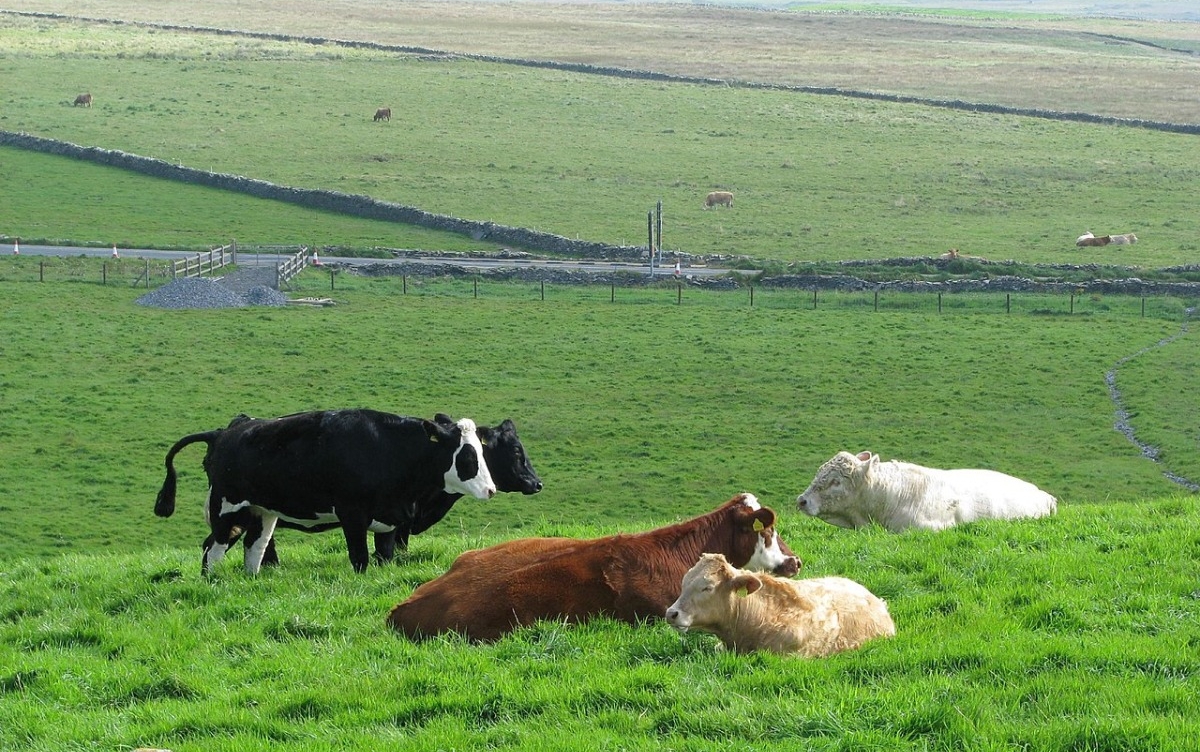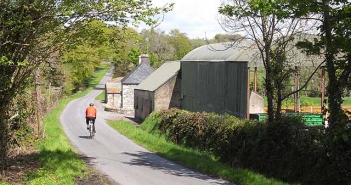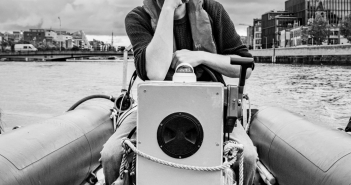Let no feeling of vengeance presume to defile
The cause of, or men of, the Emerald Isle.
From William Drennan’s ‘When Erin First Rose.’ (1795).
The intense green colour of much of the landscape of Ireland – the so-called “Emerald Isle” – bears testimony to Garrett Hardin’s assessment that ‘As a rational being, each herdsman seeks to maximize his gain’[i]. The predominance of highly verdant grassland across most of Ireland is not a natural phenomenon. In most regions hazel and oak are the summit vegetation. The synthetic fertiliser used on the abundant pastures creates an artificial glow. An outsider might assume that the absence of a ‘strong state’ is to blame for an unwieldy agricultural system dedicated to the production of meat and dairy for export, but this is not necessarily the case. This essay argues that state intervention, in the form of a land tax, could provide an important means of ameliorating a system that rewards a shrinking number of farmers, at a high environmental cost. The state can also facilitate the development of ‘alternative agriculture’, involving more sustainable environmental practices, higher employment, improved health outcomes and a reduction in the cost of living for the wider population, but this must allow farmers as Silke Helfrich puts it ‘to act like entrepreneurs on a local scale’[ii].
On the climatic periphery of grain cultivation, and with a wet climate, over millennia farmers, mainly seeking new grazing land, steadily removed most of Ireland’s native tree cover. Thus, according to Mitchell and Ryan in Reading the Irish Landscape: ‘from about five thousand years ago when the first tree-felling axes made woodland clearance possible man’s hands have borne down ever more heavily on the Irish landscape’[iii]. This left a mere twelve per cent of native woodland by the 1400s. An intensive period of British colonisation from the seventeenth century removed much of what was left, leading to the extinction of native fauna, including the wolf. The loss of access to woodland also presented enormous difficulties to a native population subjected to land seizure and discriminatory colonial laws. By the eighteenth century the poet Aodhagan Ó Rathaille asks “cad a dhéanfaifimd feasta gan adhmaid / tá deireadh na gcoillte ar lár” (Now what will we do for timber, / With the last of the woods laid low?). Today, despite ideal conditions, Ireland still has the third lowest coverage of forestry in the EU after Malta and the Netherlands, and much of that is in the form of non-native Sitka Spruce plantations that do further damage to the ecology.
Contemporary Irish agriculture is dedicated to the production of food commodities for export, principally beef and dairy that fuel climate change (the Irish agriculture sector was directly responsible for 38.4% of national Greenhouse Gases (GHGs) emissions in 2022). Despite excellent growing conditions, largescale horticulture is rare – and small-scale allotments are few in number – while public health authorities contend with a host of ‘lifestyle diseases’, linked to obesity and sedentarism. Irish agriculture is far from being the result of a free market. The system is underpinned by EU subsidies, and other regulations, which often do more harm than good.

An Irish Peasant Family Discovering the Blight of their Store by Cork artist Daniel MacDonald, c. 1847
Thus far we have not referred to the (non-native) staple crop most identified with Ireland, which appears to serve as a vivid illustration of the tragedy of the commons, and the pessimistic view of Thomas Malthus that food production fails to keep pace with population growth over time. Ireland was the first European country to adopt the potato (solanum tuberosum) as a widespread staple. This was an inauspicious development, according to John Reader, as ‘the innocent potato has facilitated exploitation wherever it has been introduced and cultivated’[iv]. The catalyst for the potato’s successful adoption was the traumatic wars of the seventeenth century especially Oliver Cromwell’s subjugation of Ireland (1649-53) since ‘the potato could both be cultivated and stored in a manner which might intuit the spirit of destruction, and the malevolence of the enemy’[v]. However, Henry Hobhouse argues that ‘of all the havoc wrought by [Oliver] Cromwell in Ireland, the by-product, the lazybed, was in the end the most damaging’[vi]. Another author, A. T. Lucas denigrated the ‘dark reign of the potato’ for ‘banishing’ most other foods from the table.[vii]
For the Irish peasant farmer the advantages of the potato far outweighed its disadvantages. The remarkable growth of the population in the eighteenth and early nineteenth centuries from approximately two million to over eight million is unlikely to have occurred without the availability of a subsistence crop whose yield exceeds that of wheat, and which was suited to Ireland’s moist, friable soil. The potato has a nutritional profile that allows for almost exclusive long-term consumption unlike most cereals, which lack the essential amino acid lysine; although the tuber has the drawback of a high glycaemic load. At the start of the nineteenth century Irishmen’s heights were greater than those of equivalent Englishmen in a variety of occupations and situations, and life expectancy was higher than most Europeans of that time. Daly has described it as ‘a wonder crop the only subsistence foodstuff which provides a nearly perfect diet, a crop which would feed a family on very little land, in almost all types of Irish soil, irrespective of rain or lack of sunshine’[viii].
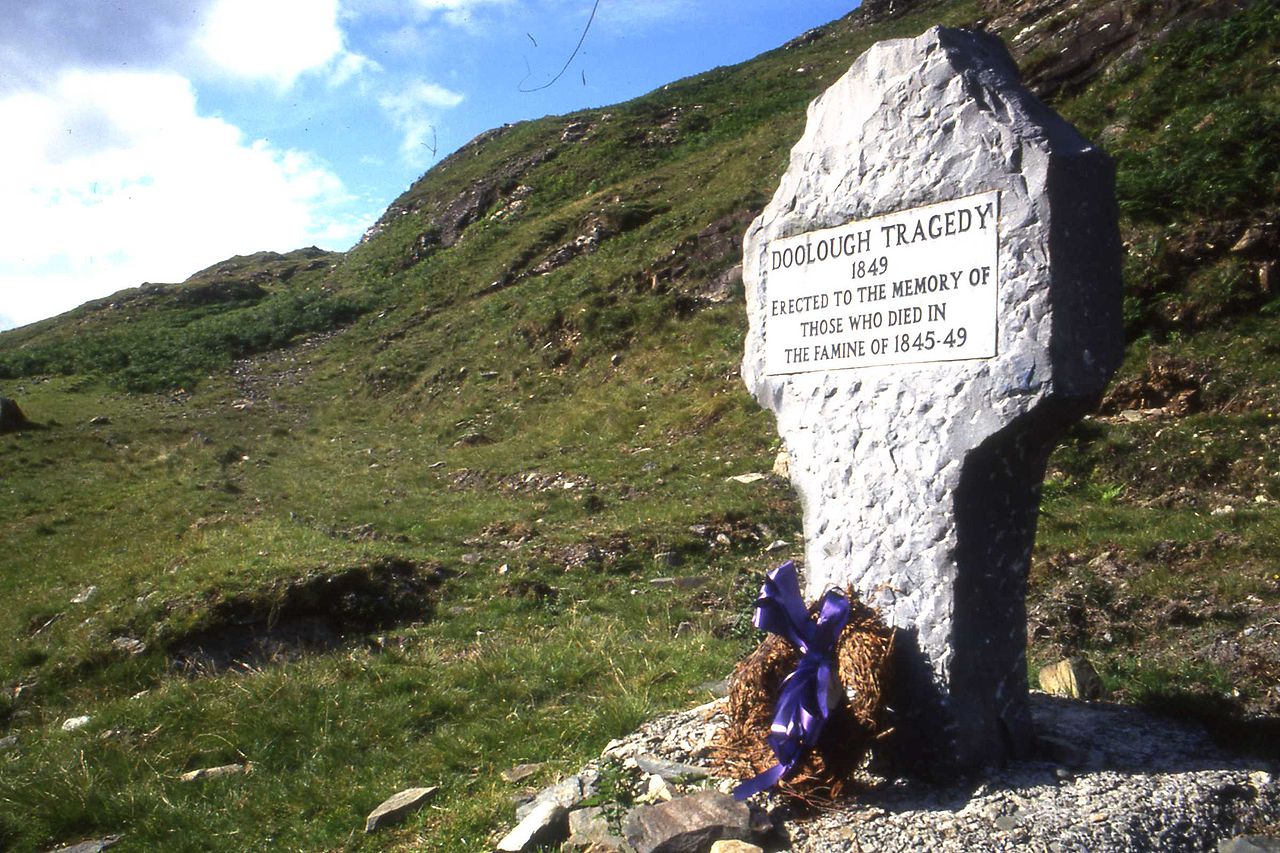
As any student of Irish history knows the story ended in tragedy with the Great Famine of 1845-51. The potato blight (phytophthora infestans) proved devastating for the three million out of a population of eight million almost exclusively dependent on it. According to Sen: ‘In no other famine in the world [was]the proportion of people killed . . . as large as in the Irish famine of the 1840s’[ix]. This was because by the eve of the Great Famine three million (out of a population of eight) were living on just one million acres of land which represented a mere five per cent of the total acreage of twenty million. Crotty argues that ‘with twenty million, instead of one million, acres of land available for the production of the population’s food requirements even with the worst conceivable crop failures, an abundance of food could have been grown to feed eight or more millions of people’[x]. This view is endorsed by Mokyr who argues that Ireland was not overpopulated on the eve of the Great Famine.[xi] Perhaps uniquely in the world, the population of Ireland has never scaled similar heights.
Over generations, peasant proprietors would have noticed that holdings were being continuously sub-divided, and that sustenance was increasing dependent on the unpalatable but prolific Lumper variety of potato. Yet the pattern of early marriage and large families endured; gynaecological brakes were not applied as seems to have occurred in other European peasant societies at that time. Importantly, during these decades of unprecedented fecundity, political activism was lacking, even in the face of the continued injustices of the Penal Laws. Notably, most of the leadership of the first republican independence movement, the United Irishmen, were from Protestant and Dissenter minorities in Dublin and, in particular, Ulster, the northern province. A Catholic society denuded of its native leadership (the Earls flew in 1607 and ‘the Wild Geese’ in 1691) failed to mobilise politically.
Surprisingly, Crotty laments the tenant land purchase schemes of the late nineteenth and early twentieth century as: ‘[t]he abandonment of competitive rent in favour of a system of peasant proprietorship naturally introduces an element of immobility into the allocation of land among farmers’. He argues that: ‘[t]here are reasons to believe that under Irish conditions this immobility is likely to be particularly severe, leading in turn to serious misallocation of land’.[xii] Thus, between 1850 and 1900 the number of cattle on Irish farms increased by over 60% and the number of sheep more than doubled. The area under tillage declined from 4.3 to 2.4 million acres, but the rural population fell from 5.3 to 3 million. The revolutionary socialist James Connolly identified the effect on rural Ireland: ‘Where a hundred families had reaped a sustenance from their small farms, or by hiring out their labour to the owners of large farms, a dozen shepherds now occupied their places’[xiii]. Crotty argues that:
concentration on cattle and sheep . . . has had an extremely harmful effect on Irish agriculture and on the whole Irish economy. While on the one hand is has led to the enrichment of the numerically small landed interest, on the other it has given rise first to famine and subsequently to chronic emigration and to very slow economic progress for the numerically much greater non-land-owning section of the population’[xiv].
The successful movement for land reform in the late nineteenth century created a society with a preponderance of peasant proprietors who maintained a model of production that offered few employment or investment opportunities.
According to Crotty: ‘The structure of the agriculture, characterized by the predominance of beef-cattle and sheep, provided little opportunity for the employment of labour or capital and with a static volume of output these opportunities did not improve’. He further contends that the interests of farmers, or landowners, and the nation ‘are essentially conflicting’; because: ‘[t]he scope for intensifying grassland beef production is very limited. The profitability of the system depends on a low rate of expenditure’[xv]. Thus, the Irish population continued to decline after independence, while the price of food tended to be at least as high as in Britain, despite far lower population density, and greater possibilities for local production.
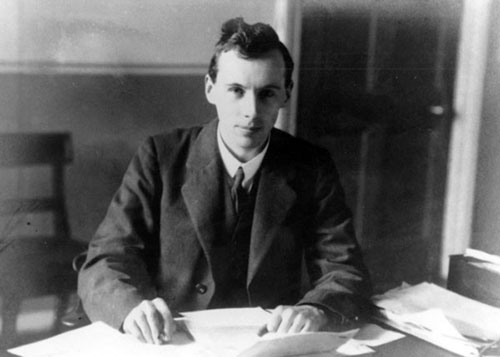
Patrick Hogan 1891-1936.
Independence brought little change in agricultural priorities with Ireland remaining a primary producer of livestock products and cattle often exported ‘on the hoof’ to Britain. This was driven by the first Minister for Agriculture Patrick Hogan (1922-32) whose sympathy lay with large cattle farmers. The early commercialisation of agriculture has cast a long shadow as farmers have continued to produce commodities for the international market, and purchase their own food from the same anonymous source. In an address to Macra na Feirme in 1974, the psychiatrist Ivor Browne observed the irrational scenario of: ‘a small farmer in Mayo taking his calf to the town to sell and his wife asking him to pick up a chicken for dinner in the supermarket while he is there; he manages to sell his calf for £1 and pays £1.50 for the chicken for dinner’[xvi]. Similarly, writing in 1968, Fennell bemoaned the demise of country markets and how a ‘frequent complaint in Ireland is the lack of variety of in vegetables for sale and the high prices charged’[xvii].
From 1972 the European Community’s Common Agricultural Policy (CAP) perpetuated this pastoral model, generating further specialisation and reducing the unprotected horticultural sector which struggled, as a result, to compete with cheap, often subsidised, imports after the removal of trade barriers. Farm supports did allow large farmers to earn incomes comparable often to urban dwellers but generated further imbalance: a miniscule proportion of Irish farmland is devoted to tillage, much of it used as animal feed; there are over seven million cattle and almost six million sheep in the country.
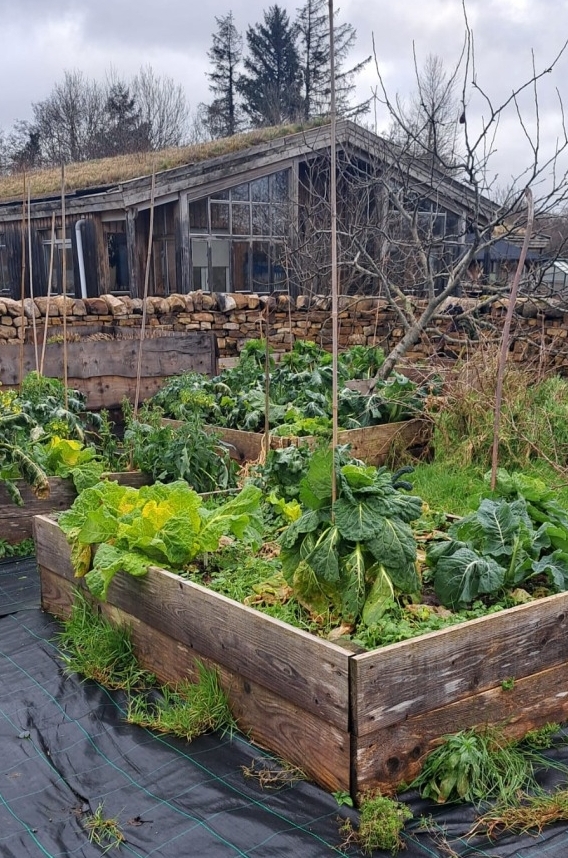
The Organic Centre, Rossinver, Co. Leitrim.
The adoption of agricultural alternatives from a variety of international ‘toolkits’ could confer significant advantages through reduced dependency on imported food, and increased employment in more labour-intensive tillage and horticulture as well as raising the health of a population that is beset by lifestyle diseases linked to a stunted food culture. One challenge for alternative agriculture is the historic inflexibility in the land market which thwarts diversification. It remains the case, as Mitchell and Ryan observed that ‘In Ireland it is still next to impossible to rent land on a lease of sufficient length to make improvements and where land can be bought it is often in small parcels at too high a price’[xviii]. The CAP subsidy regime maintains the high cost of land, as farmers are guaranteed incomes from privileged pastoral farming.
Any alternative agriculture should involve far wider direct participation than is the case today. Farmers and farm workers could work on a part-time or seasonal basis. The hinterland of cities would be especially important. Crotty argued that: ‘A land-tax offers the only means of reconciling future increases in cattle and sheep prices, relative to those of other farm products, with the general welfare’[xix]. This would involve the broadening of the property tax to encompass agricultural land. Taxation revenue emanating from any land tax could be redistributed in the form of low-interest loans, allowing enterprising individuals or cooperatives to acquire land. However, the involvement of government agencies should be restricted as according to Thirsk:
[T]he strong assumption of our age that omniscient governments will lead the way out of economic problems will not in practice serve. The solutions are more likely to come from below, from the initiatives of individuals, singly or in groups, groping their way, after many trials and errors, towards fresh undertakings. They will follow their own hunches, ideals and inspirations, and obsessions, and along the way some will even be dismissed as harmless lunatics. The state may help indirectly, but it is unlikely to initiate, or select for support the best strategies; and, out of ignorance or lack of imagination, it may positively hinder.[xx]
Thus, it will be important for farmers to “act like entrepreneurs on a local scale”.
A relatively sparsely populated island such as Ireland ought to be equipped for self-sufficiency as we enter a turbulent era in human history. Above all, for this to occur, we require a political leadership representing the interests of the people in alignment with entrepreneurial opportunities and environmental constraints. The introduction of a land tax could allow for a more equitable distribution of land, revenues from which could be used to allow individuals or cooperatives to acquire land. Any government should be mindful, however, that over-regulation may hinder development. The role of the state should be to provide access to land. Thereafter, farmers should be allowed to experiment. The history of Irish agriculture prior to the Famine, when three million were subsisting off just one million acres without artificial fertilisers or machinery, demonstrates how fertile Ireland can be. It will be necessary, however, for farmers to avoid dependence on a single staple, and for the state to insist on an increase in the coverage of native trees which provide additional ‘services’, including clean water and air.
[i] Hardin G. (1968): The tragedy of the commons. Science, New Series, 162 (3859), S.1243-1248, doi: http://www.jstor.org/stable/1724745
[ii] Helfrich S. (2009): Gemeingüter sind nicht, sie werden gemacht. In: Ostrom E. (2009): Was mehr wird, wenn wir teilen. München: oekom, S.11-19. (Helfrich 2009, p.13)
[iii] Mitchell, F. and Ryan, M., Reading the Irish landscape (Dublin, 1997), p.8.
[iv] Reader, J., The untold history of the potato (London, 2009). p.14
[v] Salaman, R., The history and social influence of the potato (Cambridge, 1949). p.215
[vi] Hobhouse, H. Seeds of change: six plants that changed mankind (London, 1985), 253..
[vii] Lucas, A. T., ‘Irish food before the Famine’, Gwerin 3 (1962)
[viii]Daly, M. ‘Farming and the Famine’, in O´ Grada, Famine 150 commemorative lecture series., p.39.
[ix] Sen, A., Identity and violence: the delusions of destiny (New York, 2006), p.105.
[x] Crotty, R., Irish agricultural production (Cork, 1966), p.63.
[xi] Mokyr, J., Why Ireland starved: an analytical and quantitative history of the Irish economy 18401850 (New York, 1985), p.291.
[xii] Crotty, 1966, p.93.
[xiii] Connolly, J., Labour in Irish history (Dublin, 1973). p.15-16)
[xiv] Crotty, 1966, p.236.
[xv] Crotty, 1966, p.117.
[xvi] Brown, I., The writings of Ivor Browne: steps along the road: the evolution of a slow learner (Cork, 2013), p 90.
[xvii] Fennell, R. ‘The domestic market for Irish agricultural produce’, in Baillie and Sheehy, Irish agriculture in a changing world, (Dublin, 1968). p. 106.
[xviii] Mitchell and Ryan, 1997, p.356.
[xix] Crotty, 1967, p.236.
[xx] Thirsk, J, Alternative agriculture: a history from the Black Death to the present day (Oxford 1997), p.256.

